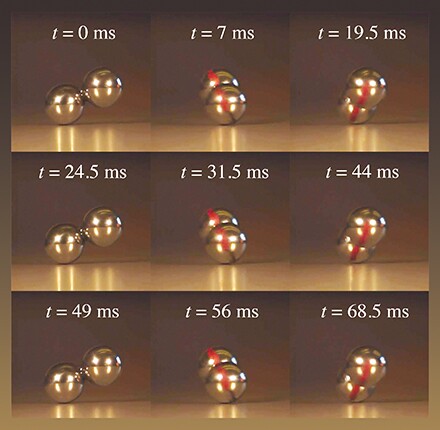The spinning double sphere
DOI: 10.1063/PT.3.3090
When two steel balls are glued together and spun on a flat surface, one ball inevitably rises above the other and the pair spins like a top with a fixed center of mass. Popularly known as hurricane balls, a spinning double sphere can easily be driven to rotation rates of more than 5000 rpm. Moreover, because it rolls without slipping, there is very little friction, so the system will remain whizzing around for several minutes. The resulting motion is quite captivating. (For the dynamics of another intriguing spinning system, see the Quick Study on page 70
As the double-sphere system spins about its axis of symmetry, it also precesses about the vertical axis. Interestingly, due to the system geometry, the spin and precession rates perfectly match, as demonstrated in the time-lapse sequence shown here. A team of researchers at Dickinson College spun up this double sphere to 2449 rpm using jets of air and filmed it at 2000 frames per second (video at http://dx.doi.org/10.1119/1.4930087.2

Readily analyzed theoretically and observed experimentally, the system is an ideal candidate for inclusion in an undergraduate course in classical mechanics. (D. P. Jackson, D. Mertens, B. J. Pearson, Am. J. Phys. 83, 959, 2015, doi:10.1119/1.4930087
To submit candidate images for Back Scatter visit http://contact.physicstoday.org




